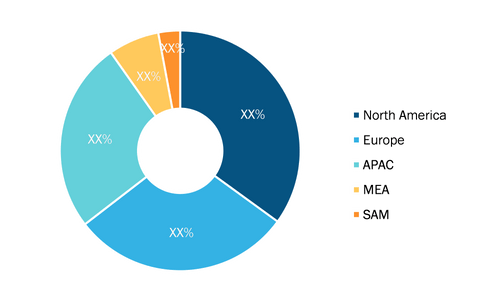Deployment of Weather Monitoring Drones Expected to Provide Growth Opportunities for Aviation Weather Forecasting System Market During 2022–2028
According to our latest market study on "Aviation Weather Forecasting System Market Forecast to 2028 – COVID-19 Impact and Global Analysis – by Component, Application, and Forecast Type," the market is expected to grow from US$ 737.09 million in 2022 to US$ 1,137.67 million by 2028; it is estimated to grow at a CAGR of 7.5% from 2022 to 2028.
Aviation weather forecasting plays a crucial role in the operations of aircraft to and from various airports. Adverse weather conditions can affect both commercial and military flight operations, putting everyone on the flight in danger. Thus, differences in climate, temperature, pressure, and humidity on the ground and at the height at which airplanes fly highlight the demand for aviation weather forecasting solutions. Airport and airline operators are increasingly adopting new and technologically advanced weather detection, monitoring, and forecasting systems and solutions to ensure proper flight operations with enhanced safety. This, in turn, is catalyzing the aviation weather forecasting system market growth across the world.
Weather drones are specifically designed to fly in the lowest layer of Earth’s atmosphere (the boundary layer), and they are equipped with thermodynamic sensors for collecting information on temperature, wind, humidity, thunderstorms, and air pressure in the atmosphere, followed by reporting the data to weather stations. The deployment of drones to collect weather data is one of the major factors expected to generate huge opportunities for market vendors during the forecast period. Real-time forecasting systems can utilize these data at airports. Real-time forecasting systems then use these data to provide weather forecasts and updates for air traffic environments. Several organizations are currently working on more efficient drone data collection systems to achieve more reliable drone weather monitoring systems that can be utilized to deliver more accurate and real-time data for weather forecasting systems across the aviation industry. The rising deployment of high-cost military drones across different military forces is also driving the demand for weather monitoring systems for weather UAV applications. The UAVs are expensive and require a skilled pilot for a flight. Some autonomous UAVs do not require pilots to be flown; however, in bad weather conditions, they cannot be operated safely without human interference. Hence, weather forecasting analysis becomes more important for weather drone operators to achieve better operational efficiency which is thereby catalyzing the aviation weather forecasting system market growth worldwide.
In 2022, North America is expected to dominate the market in terms of aviation weather forecasting system market share. The US is expected to dominate the market in North America region in 2022 in terms of aviation weather forecasting system market share. This is owing to a few ongoing projects related to airport construction, which contribute significantly to the demand for weather forecasting systems. According to an article published by CAPA in February 2019, Kansas City, New York JFK, Baltimore-Washington, and Dallas Fort Worth airports received investments of US$ 1.4 billion, US$ 2.0 billion, US$ 1.5 billion, and US$ 1.6 billion, respectively, for upgrading their operations. The development of the above airport was completed in 2021. Such investments have been contributing to the weather forecasting system market growth in North America.
In Asia Pacific, China has planned to build 215 airports by the end of 2035, which would boost the demand for aviation weather furcating systems and services in the coming years. Moreover, South Korea, India, Vietnam, and other Asian countries are also planning on the construction of new airports and expanding their existing airports. In 2020, the Airport Authority of India has decided to raise US$ 300 million for constructing new airports in five years. Such investments in airports are expected to bolster the adoption of aviation weather forecasting systems in Asia Pacific during the forecast period.
The aviation weather forecasting system market is segmented based on into component, application, and forecast type. Based on component, the aviation weather forecasting system market is segmented into hardware, software, and services. Based on application, the aviation weather forecasting system market is divided into weather stations, weather drones, weather balloons, and others. Based on forecast type, the aviation weather forecasting system market is segmented into short range, medium range, extended range, and long range.
Aviation Weather Forecasting System Market — by Region, 2022
Aviation Weather Forecasting System Market Size and Forecast (2021 - 2031), Global and Regional Share, Trend, and Growth Opportunity Analysis Report Coverage: By Component (Hardware, Software, and Services), Application (Weather Stations, Weather Drones, Weather Balloons, and Others), Forecast Type (Short Range, Medium Range, Extended Range, and Long Range), and Geography
Aviation Weather Forecasting System Market Forecast by 2031
Download Free Sample
Collins Aerospace, ENAV S.p.A., IBM Corporation, Vaisala, and Campbell Scientific Inc. are a few key aviation weather forecasting system market players profiled during the study. Several other major companies were studied and analyzed during this research study to get a holistic view of the aviation weather forecasting system market and its ecosystem. The aviation weather forecasting system market report provides detailed aviation weather forecasting system market insights, which helps the aviation weather forecasting system market players strategize their growth.
Contact Us Phone: +1-646-491-9876Email Id: sales@theinsightpartners.com